The Topsy-Turvy Vineyards Of Babcock Winery.
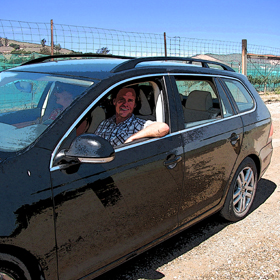
Bryan Babcock & WineSnark tour Babcock Vineyards in the Sta. Rita Hills appellation of the Central Coast.
From the back seat of Bryan Babcock’s Volkswagen I noticed something unusual about his vineyards. The grapes were experiencing an unusually early onset of veraison (when grapes soften and change color) but it wasn’t the patch-quilt appearance of the clusters that caught my attention. Babcock’s Pinot Noir vines appeared to be growing upside-down.
Babcock, a born innovator, explained, “I’ve worked out a system that allows the vines to grow more naturally. I’ve taken the starting point of my growing higher off the ground so that my shoots can grow down naturally … as opposed to working against gravity.” The visual effect can be startling to those used to seeing the traditional vertical shoot positioning (vsp) which Babcock describes as “… the status quo for coastal, fine wine growing up and down the western coast of the United States and all over the world.”
Vertical shoot positioning typically has a trunk that grows to about 2 ½ feet high, where branches called cordons sprout and grow horizontally along support wires. Each year shoots grow skyward from the cordons, harden into canes, then sprout leaves and flowers that turn into grapes. The fruit is shaded from excessive sun by the leaf canopy.
Without man’s intervention the canes can’t support the weight of the grape clusters and the vine will eventually topple over. In a system Babcock calls Canopy Pivoting the vines are allowed to do exactly that. He allows the trunk to grow to a height of 5 feet before allowing the production canes to spout horizontally. As new shoots grow skyward, gravity combines with the prevailing westerly wind to coax them back towards earth.
Canopy Pivoting is made possible through another Babcock innovation called Pedestular Cane Suspension. “The real fundamental part [of Canopy Pivoting] is that the canes float in space on pedestals. Obviously you’ve got to contain them … they’re not going to levitate on their own.” So Babcock created a steel rebar pedestal equipped with a small helix that keeps the canes suspended while allowing them to pivot freely.
Eventually the vines rotate completely, creating the unusual illusion that the vines have been turned on their heads. The fruit hangs 5 feet off the ground while the leafy canopy dangles underneath. This inverted vertical shoot positioning says Babcock “Takes the old farming and really turns it upside down because you have just as much symmetry, it’s just in the downward direction.”
“But what about the leafy canopy?” you ask. “How can it protect the fruit from excessive sunlight when it’s beneath the grapes?” Good question! I’m glad you’re paying attention.
Babcock has yet another innovation called Shade Throttling that allows farmers to manipulate sunlight. It can increase the quality of the fruit while simultaneously eliminating problems such as scorching and fruit dehydration during heat spikes.
The foliage is first stripped away from the fruiting zone and then an 18” to 20” wide shade assembly is mounted above the vines. “You can put any kind of material into that assembly,” says Babcock, “so you can choose different amounts of shade or sun you want to have on your crop depending on your row direction and the time of the year. You have complete control of the sun.”
The shade assembly material can also be graded for the time of day. “You could start off in the morning with a looser material giving you a little bit more sun when it’s cool out … In the afternoon when you need a little bit more shade and you want to bring more relief to the crop, you have a heavier material which blocks out more of the sun.”
The benefits of raising the production platform and clearing the fruit zone of excessive foliage are numerous. When the grapes are farther from the humidity of the earth there is less chance of mildew, rot and early frost damage. Less foliage increases air circulation which also reduces mildew and cuts back on the need for fungicides. If spraying is required, the open fruit zone allows for more accurate targeting, particularly late in the growing season. Hand harvesting the raised fruit is more efficient, not to mention a lot easier on the back. I’m pretty sure that one day of harvesting the low-lying fruit in a traditional vsp vineyard would put me in traction for a month.
His new raised trellis system works so efficiently with mechanical harvesters that Babcock has gotten away from hand picking all but the tightest vineyard blocks and finickiest varieties. There’s less resistance to the whacking mechanism of the harvester when the stakes are 5 feet tall, “… so it translates the oscillating energy of the harvester to the plant much more effectively” explains Babcock. “It allows us to hit the vines softer, then we can go twice as fast with the machine down the line. The energy is distributed so well to the canopy that if we don’t go fast enough [the fruit] starts to shake off in front of the machine.”
Wine pundits like to portray winemaking as part art and part science and while there is much truth in that sentiment, the fact is winemaking is predominately a business. “I think it saves me about 25% per acre, per year, of my farming costs. And as far as the winemaking team goes, it works so well with machine harvesting that I pick at night and the fruit is there waiting for my winemaker when he punches in in the morning. We don’t wait around for our fruit anymore.”
Babcock has been rebuilding his Santa Rita Hills vineyards from top to bottom for about five years, but his neighbors still crane their necks as they pass his upside-down grapevines. And while Babcock says he upended his vines to work with Mother Nature and gravity, in the end Canopy Pivoting was a pivotal business decision. The reason Babcock rebuilt his vineyards from the bottom up was to up the bottom line.


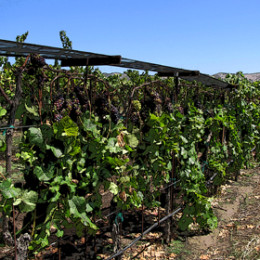
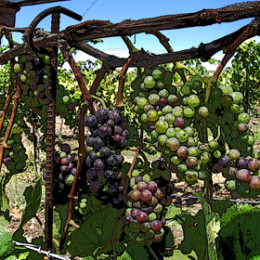
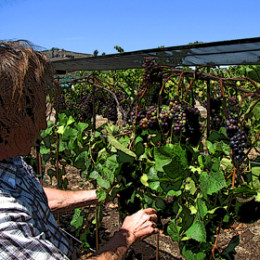
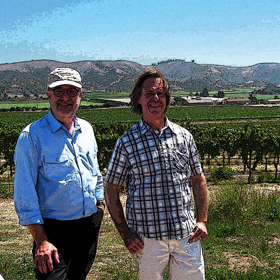



















So if the wine scores a 99, do I read it as a 66? How would the grapes respond “down under” in Australia?
I’m going to suggest Bryan invent Pestestular Points Pivoting which inverts all 66 point scores to 99, and then collectors can store the wine on a pedestal.
As for Australia, I still haven’t figured out how wine stays in a glass.